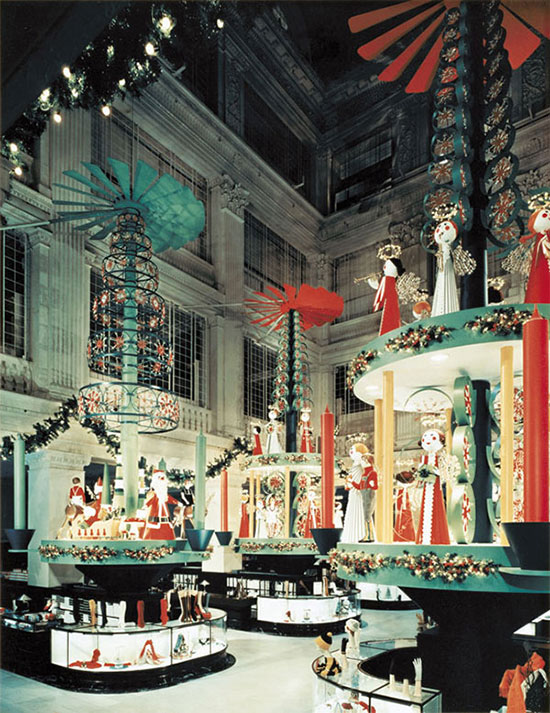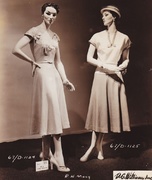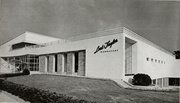
As the deadline approaches for ordering last-minute gifts online, most of us must finish our Christmas shopping the analog way—walking into stores and picking things out by hand. If you’re lucky enough to live in a city with an old-fashioned department store, you might get a glimpse of their fantastic holiday displays, packed full of animated elves and artfully piled gifts. But in most places, such scenes are extinct, remaining only in childhood memories.
“Nostalgia has always been harnessed or packaged to sell things.”
For over 150 years, familiar brands like R.H. Macy’s invested heavily in over-the-top store displays. Dr. William L. Bird, Jr., a curator at the National Museum of American History and the author of “Holidays on Display,” says that Macy’s made its name in seasonal decor when the New York City store revealed an animated shop window in 1883. “They had what they called a ‘panoply window display,’ where they took over all of the store’s front windows, installing a circular track with a mechanical sleigh. It would move around the window as if Santa were in a parade being pulled by reindeer.” Word spread of the Macy’s miracle, and shoppers would come from across town to marvel at the scene.
By the 1890s, all major department stores, like Selfridge & Co. in London or Marshall Field’s in Chicago, were committed to the Christmas display tradition. Each company attempted to outdo its rivals with more complex holiday displays, making particular use of their new plate-glass windows, a byproduct of the Industrial Revolution.

Top: Eyeing a Christmas toy display in New York, circa 1910. Above: An early rendering of an animated display at R.H. Macy’s in New York City, circa 1884.
When Lord & Taylor opened its Fifth Avenue location in New York in 1914, the store took window dressing to new heights by installing hydraulic lifts that would raise displays from a basement studio up to the street-level windows, allowing for dramatic overnight reveals. Other display innovations led to new products, like the first Lionel model train, which was invented in 1900 when the company founder, Joshua Lionel Cohen, began tinkering with ways to make a more lively toy store display. After a customer bought the first prototype right out of the window, Cohen knew he had a winner.
Prior to World War II, many stores were already threading a single narrative across all of their windows, often relating to a particular fairy tale or holiday theme. Marketing departments even created their own Christmas myths, as with Montgomery Ward’s “Rudolph the Red Nosed Reindeer,” who first starred in a free coloring book given away during the 1939 Christmas season. Most shops aimed these tableaux at children, filling them with colorful candy containers overflowing with chocolates, doll-sized villages amidst miniature snowy mountains, or stacks of bicycles and games stretching up to the ceiling.
“In terms of ambition, there was one that Macy’s did around 1959 where they made this elaborate tin front that was built onto the Broadway side of the store,” says Bird. “It was called ‘A Fantasy of Christmas,’ and was made by the Bliss Display company. But there are others we don’t have much documentation of, like the panoramic display that Tony Sarg, the champion of marionette theater, made for Macy’s in the 1920s. Sarg’s display was probably just as spectacular, with miniature castles and animated circus acts right out of his whimsical children’s books.”

Crowds form around Macy’s storefront for “A Fantasy of Christmas” in 1959, which incorporated an ornate tin facade. Image courtesy Macy’s.
Unfortunately, merchandising departments typically didn’t keep thorough records of their artistic creations, and when a new designer was hired, they sometimes destroyed all documentation of displays created by previous employees. As with Sarg’s installation for Macy’s, many fabulous displays weren’t well cataloged, and survive primarily through notes or memories. Today, holiday decor is often fueled by our sentimentality for these “simpler” times, which department stores capitalize on by filling their windows with vintage objects and imagery. But Bird believes this kind of comforting nostalgia isn’t a new trend.
“As a kid, holiday traditions are all new to you,” says Bird. “But looking at a snowy landscape or little animated figures trimming a tree was just as nostalgic in the 1950s as it is today. Those images tap into classic stories that we all know and love, and something about them elicits a very human, emotional response. It’s this larger idea of the holidays.”
Like Mr. Scrooge in “A Christmas Carol,” shoppers seem to prefer scenes of Christmases past, rather than the unknown that lies ahead. Yet retailers must still strike a delicate balance between pulling at our heartstrings and advertising their products. “Nostalgia has always been harnessed or packaged to sell things,” says Bird. “Today, they’re using new technologies and making interactive windows, but this has to be tempered, so that these displays don’t seem like anything less than a gift to the public.”
With that in mind, we invite you to pop open some eggnog and indulge yourself in a few scenes of holiday shopping from yesteryear—our gift to you.
(If you buy something through a link in this article, Collectors Weekly may get a share of the sale. Learn more.)































 Retail Therapy: What Mannequins Say About Us
Retail Therapy: What Mannequins Say About Us
 Will the Real Santa Claus Please Stand Up?
Will the Real Santa Claus Please Stand Up? Retail Therapy: What Mannequins Say About Us
Retail Therapy: What Mannequins Say About Us From Retail Palace to Zombie Mall: How Efficiency Killed the Department Store
From Retail Palace to Zombie Mall: How Efficiency Killed the Department Store Store DisplaysFrom lighted glass cabinets to simple cardboard signs, in-store displays ha…
Store DisplaysFrom lighted glass cabinets to simple cardboard signs, in-store displays ha… ChristmasCollectible Christmas items range from antique hand-crafted pieces like blo…
ChristmasCollectible Christmas items range from antique hand-crafted pieces like blo… Mari Tepper: Laying it on the Line
Mari Tepper: Laying it on the Line Nice Ice: Valerie Hammond on the Genteel Charm of Vintage Canadian Costume Jewelry
Nice Ice: Valerie Hammond on the Genteel Charm of Vintage Canadian Costume Jewelry How Jim Heimann Got Crazy for California Architecture
How Jim Heimann Got Crazy for California Architecture Modernist Man: Jock Peters May Be the Most Influential Architect You've Never Heard Of
Modernist Man: Jock Peters May Be the Most Influential Architect You've Never Heard Of Meet Cute: Were Kokeshi Dolls the Models for Hello Kitty, Pokemon, and Be@rbrick?
Meet Cute: Were Kokeshi Dolls the Models for Hello Kitty, Pokemon, and Be@rbrick? When the King of Comedy Posters Set His Surreal Sights on the World of Rock 'n' Roll
When the King of Comedy Posters Set His Surreal Sights on the World of Rock 'n' Roll How One Artist Makes New Art From Old Coloring Books and Found Photos
How One Artist Makes New Art From Old Coloring Books and Found Photos Say Cheese! How Bad Photography Has Changed Our Definition of Good Pictures
Say Cheese! How Bad Photography Has Changed Our Definition of Good Pictures Middle Earthenware: One Family's Quest to Reclaim Its Place in British Pottery History
Middle Earthenware: One Family's Quest to Reclaim Its Place in British Pottery History Fancy Fowl: How an Evil Sea Captain and a Beloved Queen Made the World Crave KFC
Fancy Fowl: How an Evil Sea Captain and a Beloved Queen Made the World Crave KFC
The photos are wonderful…..a simpler time. Thanks for sharing.
Great article Hunter! Love It!!
Happy Yuletide & a Prosperous New Year! =)
Great Article!!! and thankyou for sharing the great pictures!!
What a beautiful article w/lots of gorgeous photos. Thanks also for the great ones from Manikin. Many of us can’t afford the goods but we all stood before the windows and enjoyed and dreamed. Meant to post right after I watched “Scatter my ashes at Bergdorf’s”. And thank you for including their windows in your article. I’m the one drooling at the window and then embarrassed I can’t go into the store and buy….I need to get over that right?
what the hell has happened to our beloved country
I was looking for ideas for my Christmas window displays for my department store. I want to bring this back into fashion for my store.
You should have included Marshall Field and Carson Pirie
Scott in Chicago.